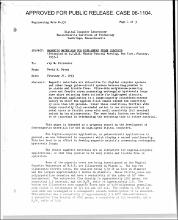| dc.contributor.author | Brown, David R. | en_US |
| dc.date.accessioned | 2009-05-04T21:30:49Z | |
| dc.date.available | 2009-05-04T21:30:49Z | |
| dc.date.issued | 1953-02-27 | en_US |
| dc.identifier | MC665_r04_E-530.pdf | en_US |
| dc.identifier.uri | http://hdl.handle.net/1721.3/38946 | |
| dc.description | Presented at A.I.E.E. Winter General Meeting, New York, January, 1953. | en_US |
| dc.description.abstract | Magnetic materials are attractive for digital computer systems and other large pulse-circuit systems because they promise to be stable and trouble free. Ultra-thin molybdenum-permalloy cores and ferrite cores possessing rectangular hysteresis loops have short switching times suitable for high-speed circuits. An important application is a large-capacity coincident-current memory in which the applied field cannot exceed the coercivity by more than 100 percent. Under these conditions, ferrites with large coercivity (1.5 oersteds) switch in one microsecond but metal cores or ferrite cores with small coercivity (0.1 oersted) switch in ten microseconds. The same basic factors are believed to be important in determining the switching time in either material. | en_US |
| dc.language.iso | en | en_US |
| dc.publisher | MIT Digital Computer Laboratory | en_US |
| dc.relation.ispartofseries | MIT DIC 6889 | en_US |
| dc.relation.ispartofseries | Project Whirlwind Engineering Note E-530 | en_US |
| dc.relation.ispartofseries | Project Whirlwind Collection, MC665 | en_US |
| dc.title | Magnetic Materials for High-Speed Pulse Circuits | en_US |
| dc.type | Technical Report | en_US |
